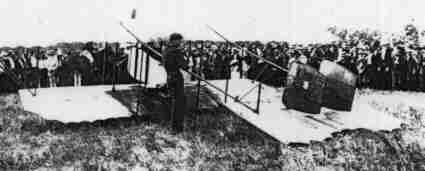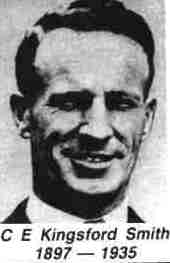|
Attending St. Andrews College Sydney, where
he was a choirboy, he went on to study electrical engineering. In WW1,after
being in the Signal Corps at Gallipoli in 1915 as a despatch rider, he
joined the British Flying Corps (later the R.A.F.). On joining No. 19 Squadron
he flew Sopwith Pups in combat and one sortie over the Somme resulted in
three toes being amputated and his getting the Military Cross. Medically
unfit he was sent back to Australia to recuperate but was invited to America
as propaganda for them to join the war in 1917, a task he revelled in.
After WW1 he did what several flyers did then, he went barnstorming in
Australia with deHavilland war surplus planes and went broke. Then the
Prime Minister (Hughes) offered £10,000 for a flight from England
to Australia in 1919, at a time when Harry Hawker had just failed to fly
the Atlantic. After that 'record' flying was his life (mainly in 'Southern
Cross',a Fokker tri motor), culminating in his death in a Lockhead Altair
named 'Lady Southern Cross' in 1935, in Burma while attempting an England
to Australia record flight. His picture is on the new $1 coin , the
$20 note and on various stamps. (Reference C.K.S. by Peter Davies and ANZ
booklet).
To have taken on eleven Jagdstaffel 11 (Richthoven's
own) pilots by flying over them single handed in a Sopwith triplane was
a daring act. For 30 minutes he out turned and out dived his frustrated
opponents and led them back over Allied guns before they gave up the chase.
He was a Navy flyer from No. 8 Squadron near Ypres. Australian top scorer
at (47 victories) of all time, he is less well known than any other 'top
scorer' in the World; although D.S.O. and bar, D.S.C. and two bars, plus
Croix de Guerre within 8 months made up for this. Initially frustrated
by Army preferences in training pilots, he went to the United Kingdom to
learn at Hendon in 1915. Posted to Naval 8 Squadron, he flew Sopwith Pups
and increased
his tally by holding back till the last moment before firing.
He
was a deadly shot on the ground too, shooting rats with precision. He lost
his life when an Allied searchlight lit up his plane and he was picked
off by a bomber rear gunner. His was one of 26,000 air casualties in WW1.
('Heroic Australian Air Stories' by Terry Gwynn-Jones) Joined the 8th Light Horse Brigade and won the
DCM at Pope's Hill, Gallipoli in 1915.Transferring to No.1 Sqdn. AFC in
Palestine he won the DFC ! Hudson Fysh (see) was his observer. After WW1
he founded QANTAS with Hudson Fysh raising most of the capital but left
in 1922 due to differences over teetotal requirements (!) to farm in Western
Australia. Then in WW2 he re-enlisted in a training capacity. ( 'qantas.com.au'
website and aust. Aviators). Next
|





